Tibet, in wild West China, is an expansive region where there are several geographical areas and unique traditions and cultures. The remote location has helped to preserve much of Tibetan culture and traditional arts. Its isolated location has protected the rich indigenous culture from modern and western influences. The majority of people living on the Tibetan plateau are farmers and nomads, and because of the country’s unique topography and widely disparate conditions, cultural and art variations have evolved over hundreds of years.
Generally you can distinguish the Tibetan art and culture between the Utsang in the west and central parts of Tibet; the Kham in the far eastern regions and the Amdo in northern Tibet. There have been cultural influences from the surrounding countries including Nepal, India, Bhutan and from other areas of China.
The culture and art of Tibet is also greatly influence by the predominant religion of Buddhism which arrived in the region in the 7th century. Since Westerners have begun visiting Tibet in significant numbers the Tibetan culture has changed slightly. The younger generation looks towards modern clothing, language and manners rather than traditions. Thankfully the deep rooted indigenous culture and artistic traditions of Tibet have survived.
The Written Tibetan Word
An essential part of Tibetan culture, Tibetan language is one of 23 spoken languages within China and the Himalayan region. Although there are different dialects in Tibet, each with its own unique pronunciation and vocabulary, they are dialects rather than independent languages. Regardless of the regional differences in the spoken language the written language of Tibet is uniform irrespective of location.
Tibetan writing was formulated in the 7th century by Thonmi Sambhota, a scholar sent by King Songtsen Gampo to study the art of writing in India. He returned to Tibet and retreated to the Phapongang Monastery where he developed the Tibetan letters based on what he had learnt in India. He formulated 30 new consonants and 4 new vowels of an entirely new written language of Tibet. He wrote eight treatises on Tibetan grammar and two have survived.
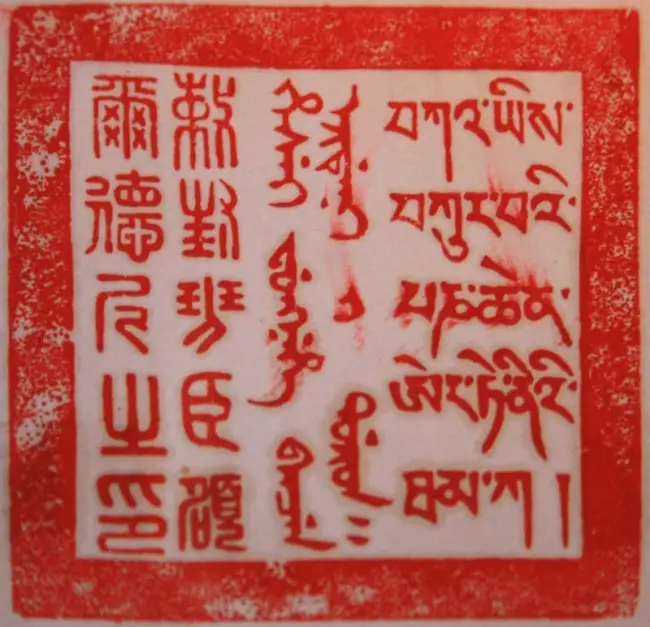
Traditional Tibetan Creatures
Yaks are one of the symbols of Tibet and always reminds people of traditional Tibetan culture. This unique animal is physically adapted for the harsh conditions and weather on the plateau. Yaks can withstand the extreme cold and high winds.
These creatures are an important part of life in Tibet providing milk which is used to make the precious butter; fat used for oil lamps; meat and fur or hair which is used to make yarn to make clothing, blankets and even tents. The yaks even provide dung for use as fuel and help in ploughing and transportation.
Tibetan Architecture
To understand Tibetan art and culture, you need to know Tibetan Architecture. Tibetan houses differ from region to region. In central Tibet the houses are built with earth, stone and wood. In the eastern region of Tibet the homes are mostly constructed from wood and have thin walls and this is the only part of Tibet where homes have peeked roofs.
In the far eastern and western parts of Tibet the structures are usually adobe and wood. In all parts of Tibet you will find beautifully, brightly decorated doors and windows bearing colorful shambu cloths.
According to Tibetan cultural traditions, the corners of the houses have “Lungta” or wind horse pray flags to end the prayers out onto the wind. Homes usually have a room dedicated to prayer. This Tibetan temple room holds religious items, painted or weaved images and appliqué Tibetan thangka painting. Rural dwellings often have an enclosure or courtyard around the home where animals are kept.
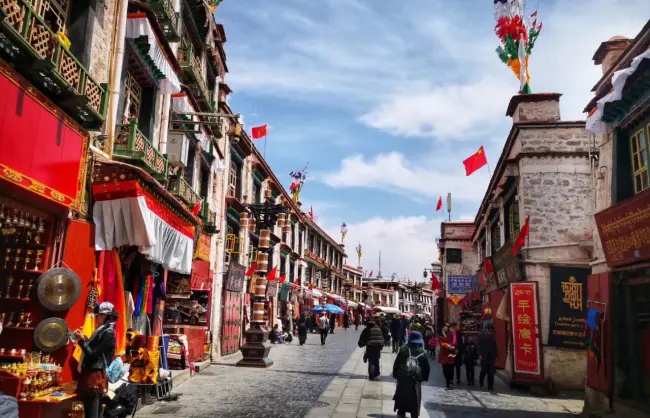
Recommended China Tibet Culture and Tour:
- 6 Days Lhasa and Tsedang Tour: Tibetan Cultural Heritage
- 6 Days Lhasa-Yamdroktso -TzedangTour with Local Tibetan Family Visit
- 5 Days Tibetan Life Experience Tour
Tibetan Cuisine
Tibetan Cuisine is also important part of Tibetan culture. Tibetans are reliant on their food to help them survive the harsh climate in Tibet. They need nourishment to keep them warm, give then energy and survive the high altitude. Tibetan farms mostly produce wheat, barley and potatoes. These crops are fast growing and can be harvested within three months.
Tibetan cuisine is mainly non-vegetarian as very few vegetables or fruits are grown on the plateau because of the harsh climate. In the south and southeastern parts of Tibet there are more vegetables grown and you can see fruit trees thanks to the warmer climate. Recently greenhouses have been introduced and now fresh vegetables are more readily available. That said Tibet has a large number of vegetarians because of the many Buddhists. Despite the many wild animals in Tibet and the abundant number of fish in the rivers you won’t see Tibetans eating seafood, fish or wild animals. Tibetans stick to domestic and bred animals.
Tibetan cuisine is very specialized due to the need for sustenance to survive the harsh climate and altitude; the available produce; the Buddhist beliefs and because at this altitude water boils at 90°C so cooking with water is near to impossible. The majority of Tibetan foods are high protein like meat and milk.
If you have some knowledge about Tibetan culture, you will know that the Tibetans use barley to make tsampa one of the Tibetan staples. Tsampa is made by roasting barley and mixing it with yak butter to produce a dough. Tsampa is perfect for the Tibetan environment as it can be stored for an extended period and eaten when the extreme winter weather prohibits farming. Tsampa is served as a dough made with buttered tea or as a porridge with beef or mutton and vegetables.
Buttered tea is also a staple of Tibet. It is drunk to warm the body and provide the necessary salts. This tea tastes more like broth than tea. Beef and mutton are often the meat of choice and are sometimes also eaten raw. Noodles are often added to meat or vegetarian dishes. Momos are a typical Tibetan food. These dumplings are made with either meat or vegetable fillings.
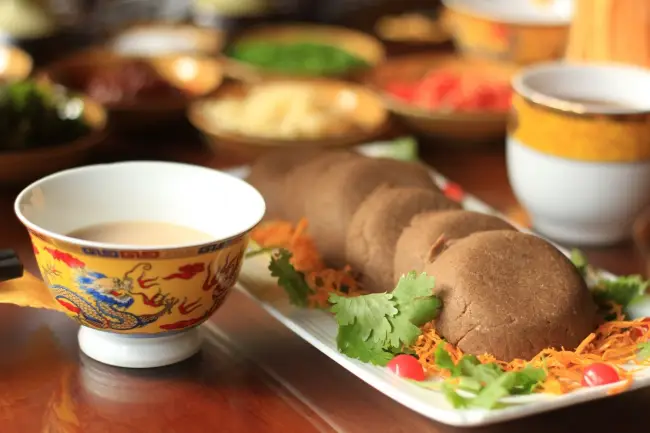
Prayer Flags of Tibetan Buddhism
When it comes to the Tibetan art of Buddhism, prayer flags comes to mind immediately. Prayer flags originated in the Bon faith when people hung prayer flags for protection. The flags were printed with symbols of tigers, dragons or snow lions. Buddhists adopted this tradition and use prayer flags printed with messages of prayer, peace or hope. The five colors of the flags symbolize the five basic elements – blue is for ether; red is for fire; white is for air; green is for water and yellow symbolizes earth.
The flags can also be printed with images of deities like Guru, Tara and Chenrezig as well as with the words of mantras. Prayer flags are placed on gateways, doorways, indoors and out. Flags are usually placed where the wind can carry the prayers through the air.
√Related reading:
- Tibetan Customs and Taboos Worth Knowing before Visiting Tibet
- Tibetan Buddhist Practices: Prostrations, Pilgrimage & Circumambulation
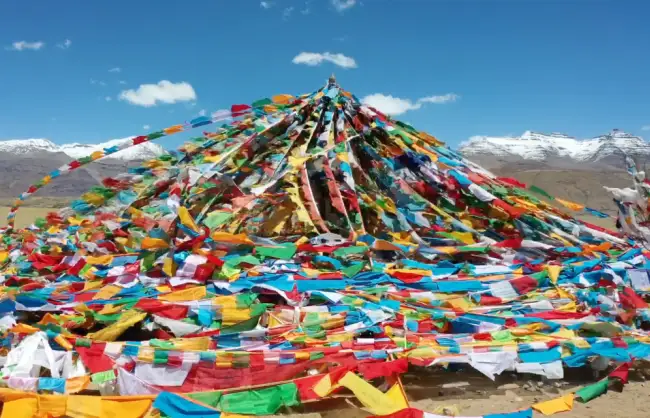
Tibetan Clothing
Learn about Tibetan art and culture from its clothing. The traditional Tibetan clothing is closely related to the Tibetan environment, history, beliefs and traditions. Each region of Tibet has its own distinct traditional garments.
Generally Tibetan clothing consists of a robe (chuba) fastened under the right arm; women where a similar robe with a narrower cut and can be with or without sleeves. Cloth belts are often worn to hold the robe in place and the robes have long copious sleeves hanging almost to the ground. The sleeves can be caught up by the cloth belt and its folds used like a pocket.
In areas of Tibet where the weather is particularly cold the robes can be lined with fur and can be very bulky. The fur-lined robes are roomy inside so that supplies can be kept under the robe close to the body out of the cold. At night the robes are used to cover them and keep them warm. The temperatures in Tibet can vary, especially from night to day so the sleeves of the robes can be worn tied around their waist in warm weather and the robe becomes a kind of skirt.
With their robes, Tibetans generally wear a shirt. Men wear a white shirt with a high collar and women wear shirts in many colors with a turned down collar. Both men and women wear cotton or woolen undergarments or they go without undergarments. On their feet they wear warm, high, loose fitting boots of untanned leather held up by a woolen garter around the top.
In rural areas the clothing is often brightly decorated. Herdsmen wear clothes hemmed with black cloth and married women in the countryside wear colorful aprons(pangden). In southern Tibet the clothing is slightly different to accommodate the warm, damp climate. Here clothing is made from hand woven wool cloth and men and women both button their clothing on the right. The men’s clothing in southern Tibet is hemmed in bright colors and the women usually wear sleeveless robes.
The weather is warmer and wetter in Lhasa than in other parts of the country and the clothing is slightly different. There is more outside, modern influence on the clothing in Lhasa than in other parts of Tibet. In Lhasa the men sometimes wear a double layered robe and women’s robes are more close fitting and with long sleeves. In Tibet you will also see religious garments like the saffron colored monk’s robes and the distinct yellow hats of the Yellow Hat order.
Related reading: Tibetans Jewelry Customs: Why Do Tibetans Always Wear Rare Baldric
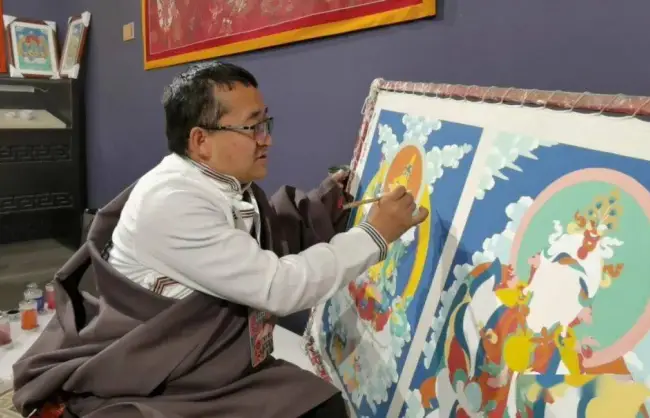
Tibetan Thangka Painting
Dip deep into Tibetan art and culture with the thangka paintings. A thangka is a Buddhist painting on cotton or silk appliqué. The paintings depict Buddhist deities or mandala (spiritual and ritual symbols representing the universe). Traditionally the thangka are unframed and rolled up like a scroll then unfurled on special occasions like festivals.
The thangka are often given a protective textile backing and silk cover. Thangka vary in size from about A4 to huge varieties spanning several meters. The practice of thangka painting has been in Tibet since the 7th century. The word “thangka “ is Tibetan for painting. Thangka are intended to spiritually inspire people through their beauty and help people meditate while giving them a visualization of their prayers.
There are several thangka painting styles – Gardi is the original graphic style; Menri is a style of thangka painting introduced from Nepal in the 9th century. You can see the Gardi style in eastern parts of Tibet and the Menri style in the western and central parts of the region. In the 16th century the Gardi style evolved thanks to the thangka artist Namka Tashi. Other leading thangka artists include Cho Tashi and Kasho Karma Tashi. Together these three artists created the Karma Gadri style.
For those planning a Tibet travel for in-depth Tibetan culture and art experience, you can admire thangka masterpieces in Potala Palace or Trundruk Monastery. Better yet, try drawing a thangka yourself.
√Related reading: Tibetan Pal Lhamo Festival – Woman’s Festival in Lhasa
Tibetan Music, Song and Dance
Music and dance together make up an important part of Tibetan art and culture. There is a strong tradition of song and dance in Tibet dating back hundreds of years. Songs are related to every aspect of Tibetan life including weddings, nature, farming, death, harvest, love, folk songs, archery, labor, drinking and more. The songs and dances really shine during Tibet’s traditional festivals when performances are in traditional dress.
Each part of Tibet has its own traditional songs and dances. For example the Guoxie village has a popular dance performed in a circle on open ground from sunrise to sunset. The traditional Guozhuang dance is popular in eastern Tibet and consists of two circles of men and women singing, swaying and stamping. As the tempo speeds up the song culminates with a loud shout of “Ya.” The Xie dance is accompanied by string instruments and danced with two lines facing each other.
The sorcerer’s dance (Qamo) is a religious dance used to subdue evil spirits. It is danced in monasteries and sometimes the dancers wear ceremonial masks. At the end of the dance a butter effigy is taken to the forest and burned.
Tibetan opera, another form of Tibetan art and culture, dates back to the 15th century and was founded by Thangthong Gyalpo. He was an engineer and he started the Tibetan opera to raise funds to finance the construction of 108 chain bridges in Tibet. Since then the function of Tibetan opera has become a cultural.

Tibetan Sky Burials
A sky burial, another mystical Tibetan cultural traditions, is when a corpse is taken to a high open place in nature where it is left to be dismembered and eaten by vultures and other creatures. The body returns to nature naturally. Tibetan Buddhism preaches rebirth of the spirit after it has left the deceased body. The body then is only a vessel to be returned to nature and become one with the elements while the person(their spirit) lives on and is reborn.
A number of Tibetan sky burial sites include Sera Shar; Dregong Thill and Darling Monastery. When the body is almost completely eaten the remains are crushed and mixed with tsampo to be eaten by the vultures. The birds nest near the sky burial sites and are revered as pure. The tradition of sky burials is also practiced among Parsees in India.
There are other methods of disposing of dead bodies in Tibet including cremation which is usually done to deceased lamas. The ashes are then entombed in a stupa. People who die of poisoning of a contagious disease are buried. There are also water burials where the body is left to be eaten by the fish. This is usually done with deceased children’s bodies. There are funeral rituals and several days of prayer in which the spirit is guided to transfer from the deceased body into the next life.









